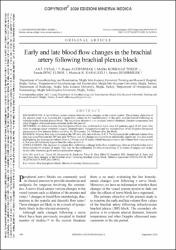Early and late blood flow changes in the brachial artery following brachial plexus block

View/
Date
2020Author
Uysal, Ali, İ.Altıparmak, Başak
Toker, Melike Korkmaz
Elibol, Funda Dinç
Karalezli, Mustafa N.
Demirbilek, Semra
Metadata
Show full item recordAbstract
BACKGROUND: A nerve block causes various hemodynamic changes in the vessel system. The primary objective of the present study is to examine the volume flow values in the brachial artery in the early and late period following an infraclavicular brachial plexus block. The secondary objective is to evaluate arterial diameter, forearm temperature and other Doppler ultrasound measurements in the late period. METHODS: An infraclavicular brachial plexus block was performed in ASA class I-II patients aged 18-65 years who were to undergo upper extremity surgery. Hemodynamic measurements and the measurement of the Doppler ultrasound parameters at five minutes before and five, 15, 30 minutes, 24, 48 hours after the block. RESULTS: Volume flow was increased at the 30th min after nerve block. A 47.17% decrease in the collected volume flow data was noted between the 30th min and 24th hour, and this change was found to be statistically significant. It is also worth highlighting the decrease in volume flow at 24 hours and 48 hours, which became closer to the volume flow value at time 0, but was still relatively higher than the value at time 0. CONCLUSIONS: The increase in volume flow following a change in the flow morphology after an infraclavicular nerve block persists for at least 24 hours. This may be the explanation for clinical advantage in all types of surgery and in particular after fractures, graft and reimplantation surgery.

















